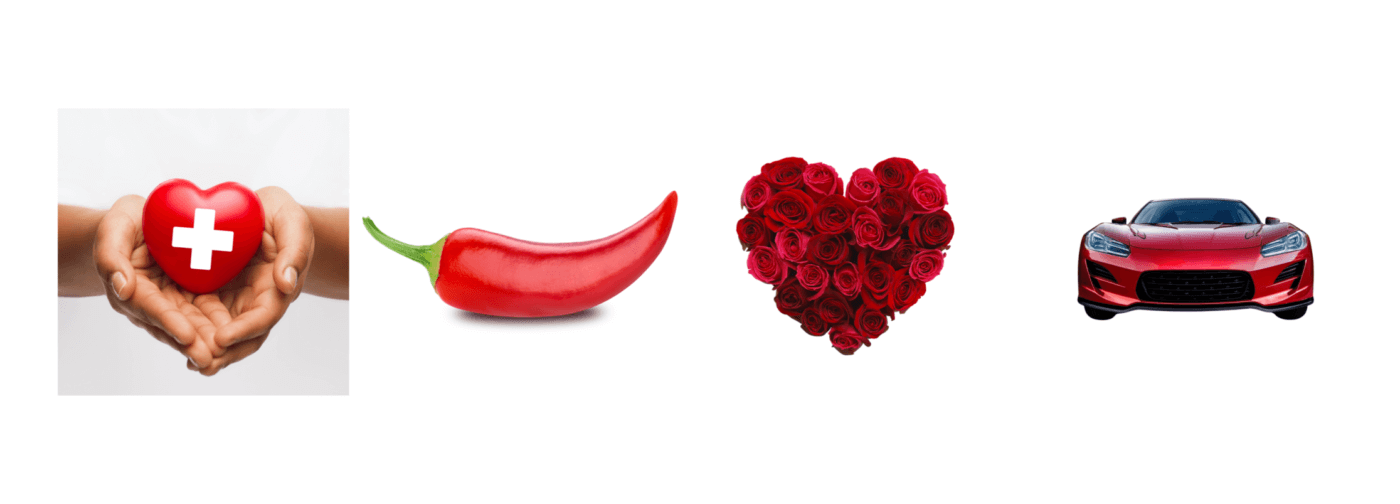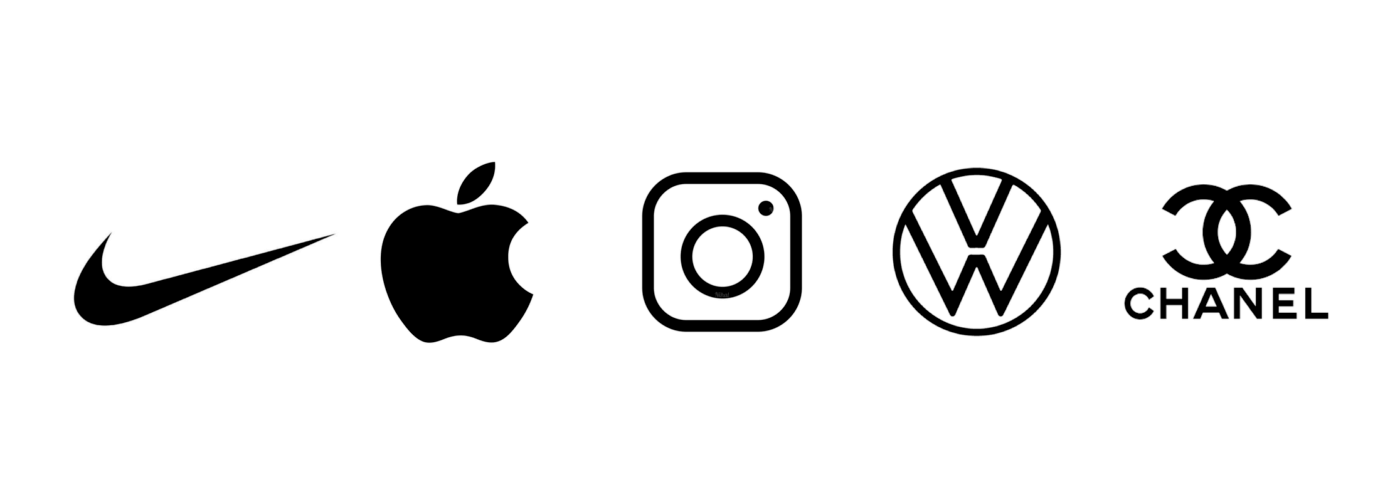Color and shape not only catch the eye, but they also guide our perception and emotions. Together, these elements transform a logo into an icon, a package into a feeling, and a brand into a relationship. Studies show we process images 60,000 times faster than text, as the majority of information we absorb is visual, and more than 80% of visuals are driven by colors and shapes. In a market where consumers are exposed to hundreds of brand messages daily, these visual elements serve as cognitive shortcuts that help people decide what to buy.
How to Make Connections with Color
Color is often oversimplified in branding. Red is passion. Blue is trust. Green is clean. But context changes everything. Red on a Valentine’s Day card says love. On a financial statement, it means a loss. On a bottle of hot sauce, it signals heat. When working on a brand transformation, refresh, or launch, we help clients evaluate color through three critical lenses:
1. Existing Brand Equity
If a brand already “owns” a color in consumers’ minds, walking away from that association is a high-stakes move. For brands with reputational damage, a shift might be warranted, but in most cases, it’s better to evolve the shade or complement it with a new color system.
A recent example is Google’s newest logo update. Google unveiled a refreshed design of its “G” logo, the first significant update since 2015. The redesign transitions from the traditional solid red, yellow, green, and blue segments to a smoother gradient blend of the same colors. This subtle yet significant change underscores Google’s commitment to evolving its visual identity in tandem with its technological advancements, particularly in the realm of AI. However, at the same time, it maintains recognition with its original color palette and shape.
2. Category Context
In some categories, colors have come to communicate very specific things. In the context of cleaning products, green has come to symbolize “clean” products, while in the context of food, it often denotes vegetarian or plant-based. It’s not impossible to go against some of these norms if there are other factors at play: for example, Starbucks uses green in its logo because the character in the icon is a mermaid.
3. Competitive Brand Colors
In certain industries, color conventions dominate. Think of navy blue in finance, or green in cleaning and wellness. Breaking from the norm is an opportunity to differentiate. A disruptive brand like Tangerine uses a distinctive colour to set itself apart, in a strategic way. It works because they are a digital bank with no branches; they have a unique approach that allows them to step out from the pack. For brands with existing color equity, pairing with unique shapes or secondary colors, can also create a distinct identity without losing familiarity.


Image Source: Shutterstock
Disruption Through Unexpected Color
Aligning with category color norms can support instant recognition and build consumer confidence. But these color codes can feel homogenous and uninspiring. As mentioned, when used strategically, unexpected color can break through visual clutter and create a memorable emotional jolt, the kind of moment the Blink Factor is designed to leverage.
It’s important to remember that a bold color strategy must still be familiar enough to be credible, especially if the product requires a high level of trust, such as food, finance, and health. Our research shows that consumers notice color disruption instantly, but whether they trust it depends on whether the emotional message matches their expectations and desires.
Here are some key principles to follow when using unexpected color:
- One way to balance this is through hybrid approaches: pairing a disruptive base color with familiar secondary cues, guiding traffic with color zones in physical spaces, or keeping structural packaging elements traditional while allowing color to carry the surprise. This blend of surprise and reassurance creates intrigue without alienation.
For example, in our work with Vivitas Women, the bottle’s shape was emotionally powerful, a silhouette of a pregnant woman. That shape did the emotional heavy lifting. Had the brand also chosen a color completely outside the category norm (say, brown or grey), the combination might have felt confusing. But by keeping the color warm and reassuring, the design struck the right balance of distinctiveness and emotional clarity.
Image Source: SLD
- Analyze the color landscape of your category. What hues dominate? What messages are repeated over and over? Now look at what’s missing. This “white space” is where a new color can make a bold impression, especially if that color aligns with the brand’s positioning or personality. Big brands like Celsius are already making this shift by moving away from the typical, high-contrast colors of the energy drink category, such as black, red, metallic silver, and neon green. Instead the brand uses softer accent tones with predominantly white backdrops. This signals a new kind of energy—focused, balanced, perhaps even wellness-oriented. It attracts an audience less interested in extremes and more drawn to mindfulness, productivity, or clean ingredients. At the same time, these color schemes stand out on the shelf.
Image Source: Celsius Official Website
The Emotional Language of Shape
Like color, shapes are also imbued with psychological meaning. Circles suggest inclusiveness, unity, and softness, while squares and rectangles evoke structure, reliability, and security. In branding, however, shapes are rarely used in pure geometric form; most brand icons go beyond textbook shapes and use form more expressively. To harness the power of shape in branding and packaging, here are key strategies marketers should consider:
1. Leverage Symbolism
The most enduring logos carry symbolic weight. Amazon’s arrow isn’t just a smile; it points from A to Z, reflecting Amazon’s impressive product range. Consider how a shape can function as a metaphor for what your brand offers.
2. Create Unique Iconography
Develop a custom symbol or silhouette that conveys brand tone, whether it’s more grounded, playful, or precise. Take the Nike swoosh, for example; it’s not a recognizable geometric shape, but it is bold, directional, and emotionally charged. It suggests movement and momentum, making it an icon with meaning.
3. Use Typography as a Shape
Shapes are often embedded into wordmarks or custom fonts, giving the brand a subtle but recognizable edge. Think of the mirrored “C”s in Chanel or the classic Warner Brothers shield. These designs use typography to create shape and, in doing so, embed meaning into every letter.
4. Maintain Visual Consistency Across Applications
Just like color, shape can function as visual shorthand. Use a repeated shape motif (e.g., tear-drop, arch, hexagon) across your packaging, signage, and digital presence.


Image Source: Shutterstock
Takeaway
The power of color and shape does more than attract attention; it anchors memory, drives preference, and signals brand ownership. Especially, in categories where the shelf is crowded and consumers decide in seconds, these elements become assets that can’t be easily replicated. That’s the Blink Factor in action, design that’s not only seen, but also felt.

